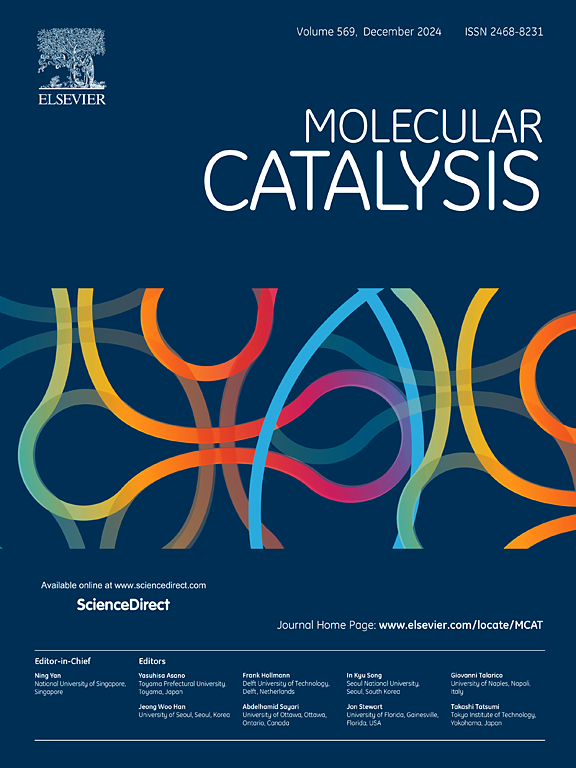Production of 5,5′(oxy-bis(methylene)) bis-2-furfural from 5-hydroxymethylfurfural through the hydrogen-bonding catalysis of ionic liquids
IF 3.9
2区 化学
Q2 CHEMISTRY, PHYSICAL
引用次数: 0
Abstract
5,5′(oxy-bis(methylene)) bis-2-furfural (OBMF) is an important biobased chemical that can be synthesized through the self-etherification of 5-hydroxymethylfurfural (HMF) in the presence of either homogeneous acid or solid acid catalysts, such as p-toluenesulfonic acid (PTSA) and molecular sieves. In previous studies, all authors believed that this process follows an acid-catalyzed mechanism, even though some argued that acid strength is not the key factor in the formation of OBMF. In this work, we present a new route for the synthesis of OBMF from HMF, utilizing hydrogen-bonding catalysis with protonated ionic liquids under metal-free conditions. [NMPH][OTf] featuring a cationic hydrogen bond donor and an anionic hydrogen bond acceptor, is effective for the self-etherification of HMF. Under the optimal conditions, the yield of OBMF reached approximately 92.4 %. Based on the results of Attenuated Total Reflectance Infrared Spectroscopy (ATR-IR), Nuclear Magnetic Resonance (NMR) and Density Functional Theory (DFT) calculation, it is determined that the cations and anions of ILs could activate the C![]() O and O
O and O![]() H bonds of HMF via hydrogen bonds respectively. This synergistically facilitates the self-etherification of two HMF molecules to form OBMF. After recycling the catalyst four times, the yield of OBMF did not decrease significantly. According to the Arrhenius law, the apparent activation energy and reaction order for [NMPH][OTf] in the self-etherification of HMF to OBMF are determined 40.7 kJ/mol and 1.0, respectively. The results suggested that [NMPH][OTf] is an excellent catalyst for the generation of OBMF from HMF. Therefore, this study offers a simple and environmentally friendly method for the production of OBMF, which holds promising potential for broad application prospect in the future.
H bonds of HMF via hydrogen bonds respectively. This synergistically facilitates the self-etherification of two HMF molecules to form OBMF. After recycling the catalyst four times, the yield of OBMF did not decrease significantly. According to the Arrhenius law, the apparent activation energy and reaction order for [NMPH][OTf] in the self-etherification of HMF to OBMF are determined 40.7 kJ/mol and 1.0, respectively. The results suggested that [NMPH][OTf] is an excellent catalyst for the generation of OBMF from HMF. Therefore, this study offers a simple and environmentally friendly method for the production of OBMF, which holds promising potential for broad application prospect in the future.

求助全文
约1分钟内获得全文
求助全文
来源期刊

Molecular Catalysis
Chemical Engineering-Process Chemistry and Technology
CiteScore
6.90
自引率
10.90%
发文量
700
审稿时长
40 days
期刊介绍:
Molecular Catalysis publishes full papers that are original, rigorous, and scholarly contributions examining the molecular and atomic aspects of catalytic activation and reaction mechanisms. The fields covered are:
Heterogeneous catalysis including immobilized molecular catalysts
Homogeneous catalysis including organocatalysis, organometallic catalysis and biocatalysis
Photo- and electrochemistry
Theoretical aspects of catalysis analyzed by computational methods
文献相关原料
公司名称
产品信息
阿拉丁
Methyl tert‐butyl ether
阿拉丁
[Bpy][NTf2]
 求助内容:
求助内容: 应助结果提醒方式:
应助结果提醒方式:


